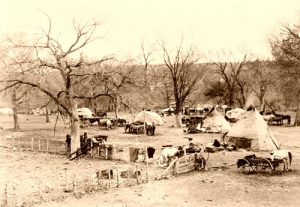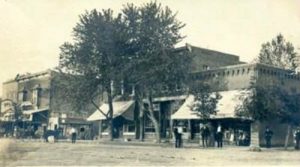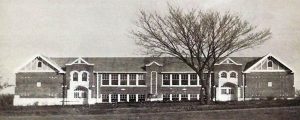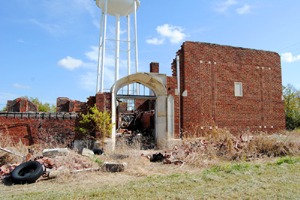Situated in the northwestern part of Montgomery County, Kansas, at the confluence of Duck Creek with the Elk River, Elk City began as a trading post established by John Kappell in early 1868 when the area was still part of the Diminished Reserve of the Osage Indians. Building a small cabin that doubled as the trading post, Kappell bartered his wares with the Indians for their furs and supplied area settlers with a few necessities at high prices.
Located on the rich bottomland of the Elk River in a valley surrounded by stone and oak-covered hills, several people thought the location was ideal for a townsite. In December 1868, a town company was organized. Elk City became the first town established in Montgomery County.
The next business to start in the town was that of A. E. Baird in a log building, which sold general merchandise. The following year, S.B. Davis, T.J. Brown, and Samuel Maples built the first sawmill. At that time, the school was taught by William Osborne in a log house belonging to a man named Chandler. In Osa Sherman’s store, a post office was established at Elk City in November 1869. A couple of years later, M.D. Wright, who owned the stationery and notions store, became the postmaster, and his store became the post office.
More businesses came in 1870 when M.D. Wright began selling stationery, notions, and other items in a little log building. A.R. Quigg engaged in the hardware trade, and J. P. Morgan built a blacksmith shop. At some point, Kappel’s old trading post, after undergoing an overhaul with a new front, became Watts & Masterman’s furniture store.
With more and more people coming to the area, the settlement’s population increased enough to officially become a city of the third class in the spring of 1871. That same year, plans were underway to build a school for the children in the community. In the meantime, they attended school in a building erected by Thomas Harris for a hotel until the school was completed in January 1872. The one-room building was a one-story, frame structure measuring 26 feet by 40 feet.
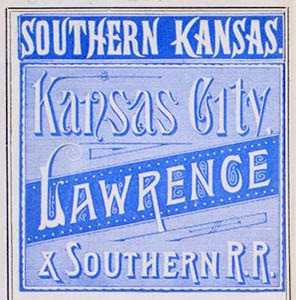
Kansas City, Lawrence & Southern Railway.
Although Elk City later proved to be a successful attempt at town-building, its beginning was made amid spirited rivalry. Bloomfield, about a mile northeast, and Tipton, a little way east of the town, were established and sought to win in the race for supremacy. But Elk City took the lead, outstripping these two places, which no longer existed.
In 1879, the Kansas City, Lawrence & Southern Railway was constructed to Elk City, which was advantageous in stimulating its improvement and growth.
The Presbyterian Church was organized in 1880, and a church was built the same year. The one-story stone structure not only served the Presbyterians but also several other church congregations.
By the early 1880s, the town boasted a population of about 500, a school, and several large brick business buildings, including a hotel. By this time, the school was becoming too crowded, and a new two-story brick building was erected in the fall of 1882 when the city’s pupils numbered 218.
In 1882, the Missionary Baptist Church purchased and remodeled the old school building to make it a place of worship.
The first bank, the Elk City banking house, was established in March 1881. By 1883, the town supported several manufacturing facilities, including the sawmill, the Elk City flouring mill owned by Wright & Musson, and a brickyard owned by Price & Woodring. Other smaller factories, including wagon shops and a manufacturer for making the Double Spiral Bed Springs.
In 1890, Elk City reached its peak population of 796.
By the turn of the century, two railroads were running through the city — the Missouri Pacific Railroad and the Atchison, Topeka & Santa Fe Railroad. In 1902, a company was organized to prospect for oil and gas. After several initial failures, gas was found, and several companies began operations in the area.
By 1910, the town boasted brick and tile manufacturing facilities, a flour mill, a weekly newspaper, two banks, express and telegraph offices, a post office with six rural routes, and a population of 659.
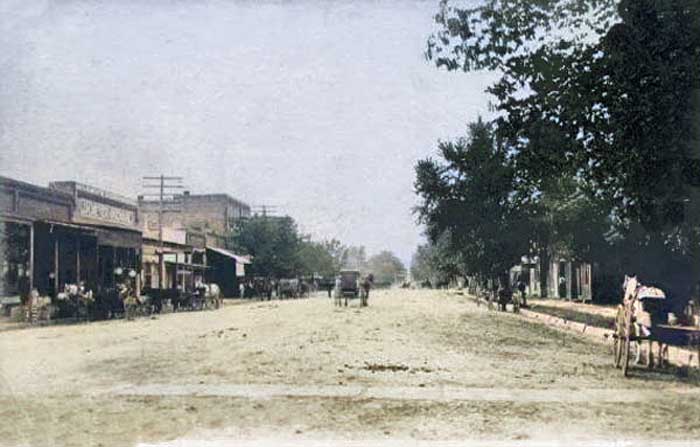
Elk City, Kansas, in 1907.
Elk City remained a small town for the next several decades, with its population fluctuating between 60 and -700 people through 1940. In the meantime, the number of students in the area again demanded a new school. In 1929, a beautiful new high school was built. Previously, all grades used to attend school in the same building.
After 1940, Elk City’s population began to drop each decade. As more and more people continued to leave, businesses began to close one by one. The high school continued to serve students until 1970, when it graduated its last class. Sometime along the way, the grade school also closed. Elk City’s High School remained standing and silent for more than four decades until it was engulfed by fire, and today, only the rubble remains.
Today, Elk City is home to just over 300 people and is a near ghost town, with several abandoned buildings. Students attend school in Independence, about 15 miles to the southeast. The town still boasts a post office, a bank, and a tavern amongst its many vacant business buildings. Unfortunately, Elk City lost another historic building in May 2015 when the 1900 historic 1st Christian Church was destroyed by fire.
Residents and visitors enjoy nearby Elk City Lake, which is famous for its large catfish. The lake offers boat ramps, a swim beach, camping, playgrounds, hiking trails, and picturesque views of open prairie, wooded hills, and limestone bluffs. Wildlife watchers can see a variety of Kansas wildlife, including the large pileated woodpecker, which is common in the mature trees along the Elk River.
More Information:
Elk City, Kansas
114 N. Montgomery
P.O. Box 245
Elk City, Kansas 67344
620-627-2483
Compiled and edited by Kathy Alexander/Legends of Kansas, updated April 2025.
Also See:
Montgomery County Photo Gallery
Sources:
Blackmar, Frank W.; Kansas: A Cyclopedia of State History, Vol I; Standard Publishing Company, Chicago, IL 1912.
Cutler, William G.; History of Kansas; A. T. Andreas, Chicago, IL, 1883.
Elk City, Kansas State Park


